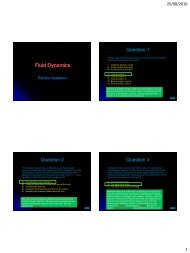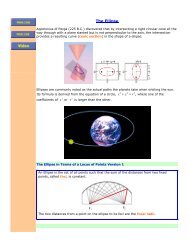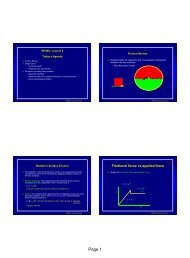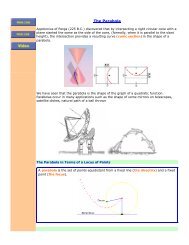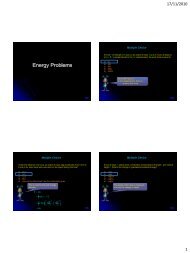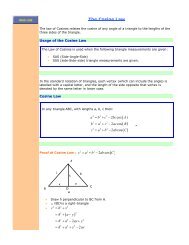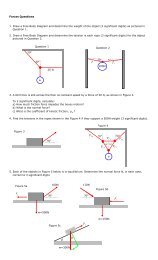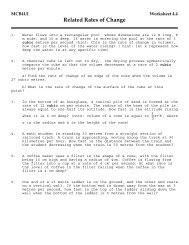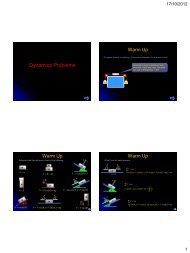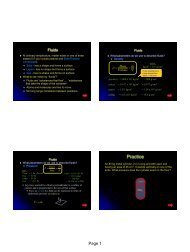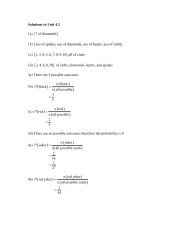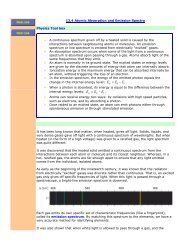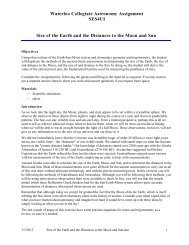Population Growth Exponential vs Logistic Growth - The Burns ...
Population Growth Exponential vs Logistic Growth - The Burns ...
Population Growth Exponential vs Logistic Growth - The Burns ...
You also want an ePaper? Increase the reach of your titles
YUMPU automatically turns print PDFs into web optimized ePapers that Google loves.
<strong>Population</strong> <strong>Growth</strong><strong>Exponential</strong> <strong>vs</strong> <strong>Logistic</strong> <strong>Growth</strong>In the “real world” the population growth is a discontinuous functionof time (population takes on only whole numbers). A common way tomodel a population is with a differential function P which is growingat a rate proportional to the size of the population.<strong>Population</strong> <strong>Growth</strong>dP kPdt Which can be rewritten as:dPdt kP <strong>The</strong> constant k known as the Relative <strong>Growth</strong> RateExampleFind an initial value problem model for world population table and useit to predict the population in the year 2010.World <strong>Population</strong> TableYear <strong>Population</strong> (Millions) Ratio (e k )2000 608561596085 1.01222001 61592002 62322003 63052004 63776232 1.0116159 6305 1.0116232 63776305 1.011
Solution:If we let t=0 represent 2000, then t=10 represent 2010.From the tablee k is approximated by the value 1.011Now since dPdt kP , we have k being about 0.0109.dPDifferential Equation: 0.0109PdtInitial Condition:P0 6085Solving this gives usP 6085eP 106085e6785.80.0109 t0.109<strong>The</strong> world’s population is expected to be about 6.8 billion people by2010.<strong>The</strong> problem with exponential growth models is that they assumeunlimited growth. This unlimited growth assumption is only valid forsmall periods of time. <strong>The</strong> environment will place a constraint on thegrowth and a more realistic model is used. <strong>The</strong> <strong>Logistic</strong> <strong>Growth</strong>Model.<strong>Logistic</strong> <strong>Growth</strong>dPdtP P k1MdP k P M P or dt MWhere M is a maximum population or carrying capacity that theenvironment is capable of sustaining.
ExampleA farm is known to support no more than 100 cows. <strong>The</strong> farmcurrently has 10 cows. Model the population with a logistic differentialequation with k 0.1 . And find how long it takes for the farm to reach25 cows.Solution:dP k P M P dt M0.1 P 100P1000.001P100 PWe knowP0 101 dP0.001P 100P dt1 1 1 dP0.001 ; separation technique100 P 100 P dt1 1 dP 0.1P 100 P dtln P ln 100 P 0.1t CPln 0.1tC100 P100 Pln 0.1t CP100 P0.1tCeP100 PC 0.1t e eP100 10.1t AeP100P 0.1t1 AeThis is the general solution to the differential equation. When t=0 weknow P=10.10010 1 Ae1A10A 90
100This gives us the <strong>Logistic</strong> growth Model: P 0.1t1 9 e Now to determine when P=2510025 1 9e0.1t19 e 40.1t9e3e0.1te0.1t133ln 3t 0.1110.1tIt would take about 11 years to reach 25 cows.<strong>The</strong> growth curve is represented below.



